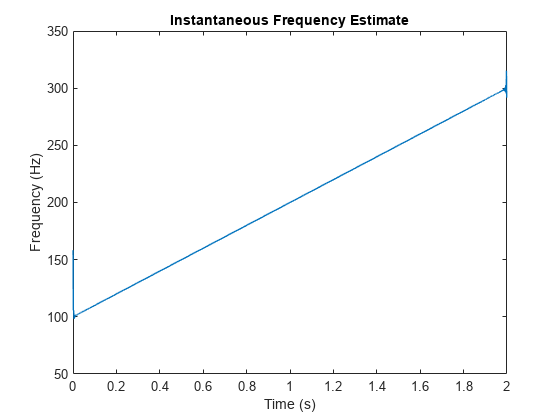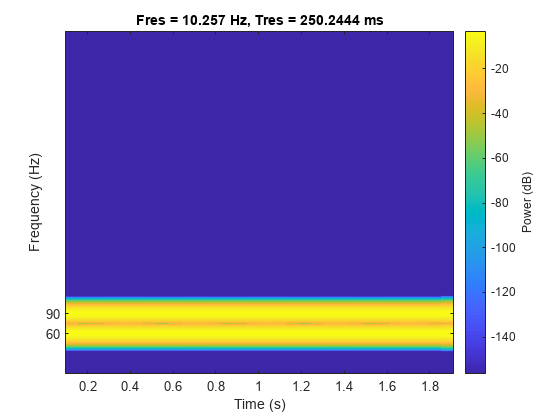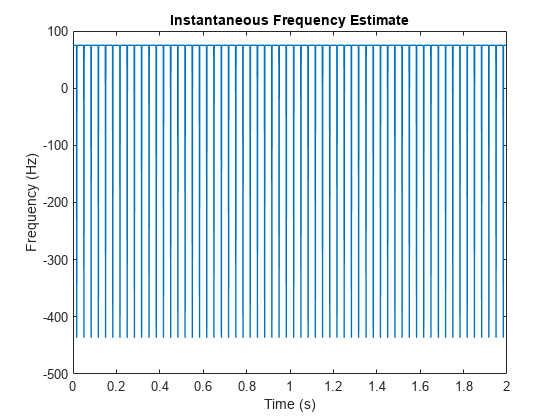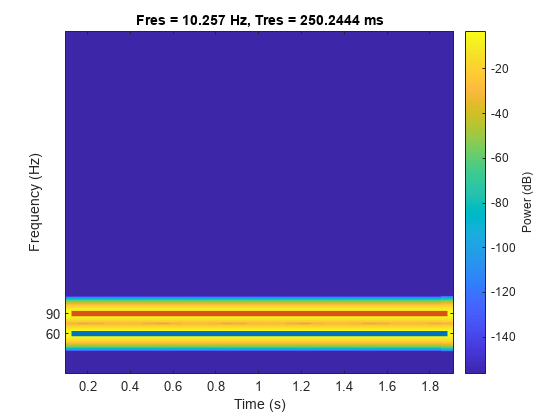힐베르트 변환과 순시 주파수
힐베르트 변환은 단일 성분 신호에 대해서만 신호의 순시 주파수를 추정합니다. 단일 성분 신호는 시간-주파수 평면에서 단일 "리지"로 설명됩니다. 단일 성분 신호 세트는 단일 정현파를 포함하며, 처프(Chirp)와 같은 신호도 포함합니다.
2초 동안 1kHz로 샘플링된 처프를 생성합니다. 주파수가 처음에는 100Hz이고 1초 후 200Hz로 증가하도록 처프를 지정합니다.
fs = 1000; t = 0:1/fs:2-1/fs; y = chirp(t,100,1,200);
pspectrum 함수에 구현된 단시간 푸리에 변환을 사용하여 처프의 스펙트로그램을 추정합니다. 각 시점에서의 단일 피크 주파수로 신호가 잘 설명됩니다.
pspectrum(y,fs,'spectrogram')
해석적 신호를 계산하고 해당 위상을 미분하여 순시 주파수를 측정합니다. 스케일링된 도함수는 유의미한 추정값을 생성합니다.
z = hilbert(y); instfrq = fs/(2*pi)*diff(unwrap(angle(z))); clf plot(t(2:end),instfrq) ylim([0 fs/2])

instfreq 함수는 순시 주파수를 계산하고 표시하는 작업을 한 번에 처리합니다.
instfreq(y,fs,'Method','hilbert')

신호가 단일 성분이 아닌 경우에 이 방법은 실패합니다.
2초 동안 1023Hz로 샘플링된, 주파수가 60Hz와 90Hz인 두 정현파가 결합된 신호를 생성합니다. 스펙트로그램을 계산하고 플로팅합니다. 각 시점마다 두 성분이 존재하는 것을 알 수 있습니다.
fs = 1023;
t = 0:1/fs:2-1/fs;
x = sin(2*pi*60*t)+sin(2*pi*90*t);
pspectrum(x,fs,'spectrogram')
yticks([60 90])
해석적 신호를 계산하고 해당 위상을 미분합니다. 정현파의 주파수를 포함하는 영역을 확대합니다. 해석적 신호는 정현파 주파수의 평균에 해당하는 순시 주파수를 예측합니다.
z = hilbert(x); instfrq = fs/(2*pi)*diff(unwrap(angle(z))); plot(t(2:end),instfrq) ylim([60 90]) xlabel('Time (s)') ylabel('Frequency (Hz)')

instfreq 함수는 평균도 추정합니다.
instfreq(x,fs,'Method','hilbert')

시간 함수로 두 주파수를 모두 추정하려면 spectrogram을 사용하여 파워 스펙트럼 밀도를 구하고 tfridge를 사용하여 두 리지를 추적하십시오. tfridge에서 주파수 변경 벌점을 0.1로 지정하십시오.
[s,f,tt] = pspectrum(x,fs,'spectrogram'); numcomp = 2; [fridge,~,lr] = tfridge(s,f,0.1,'NumRidges',numcomp); pspectrum(x,fs,'spectrogram') hold on plot3(tt,fridge,abs(s(lr)),'LineWidth',4) hold off yticks([60 90])
